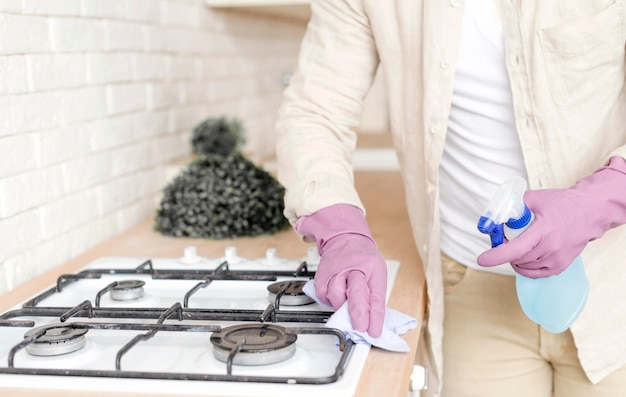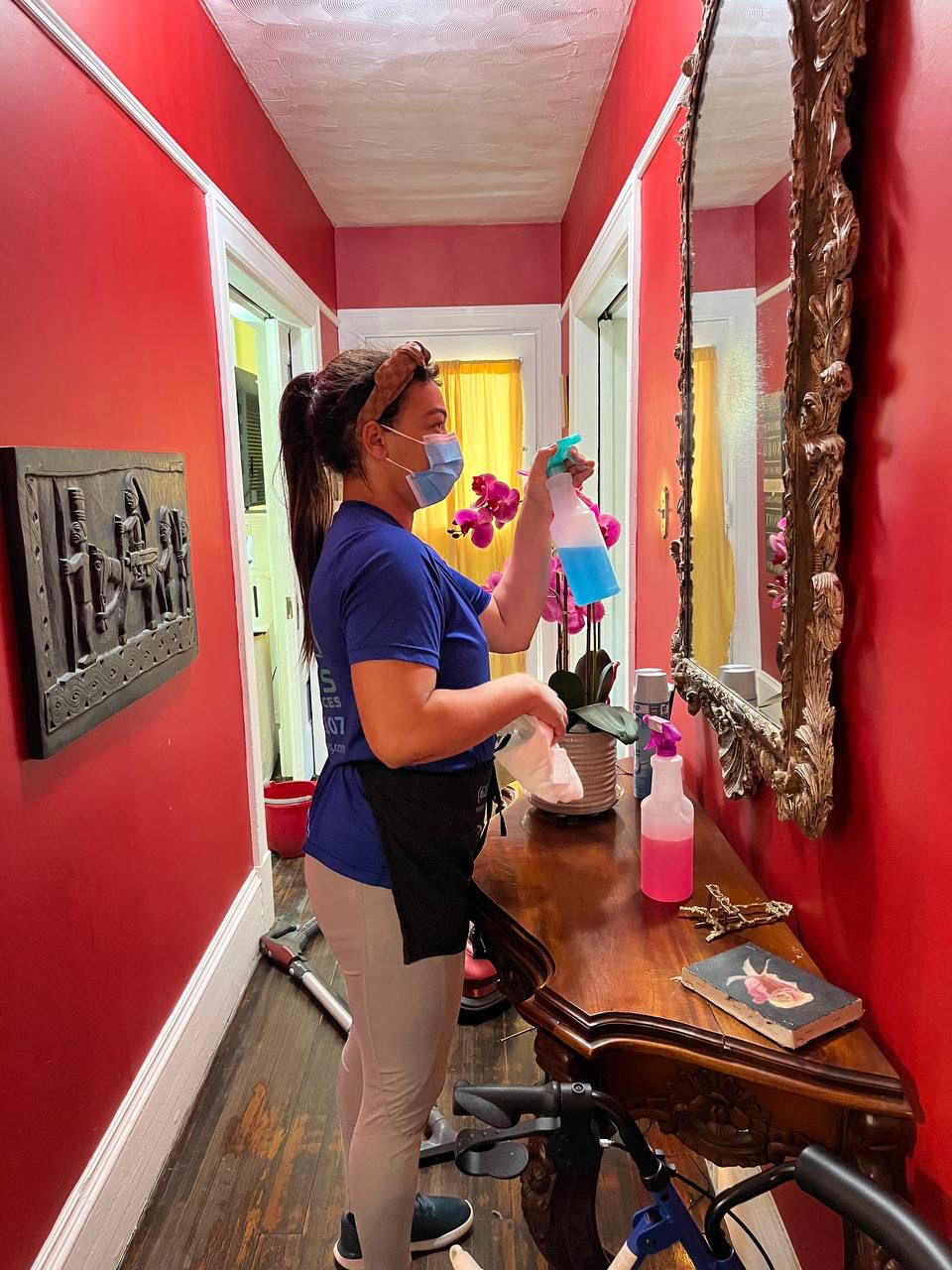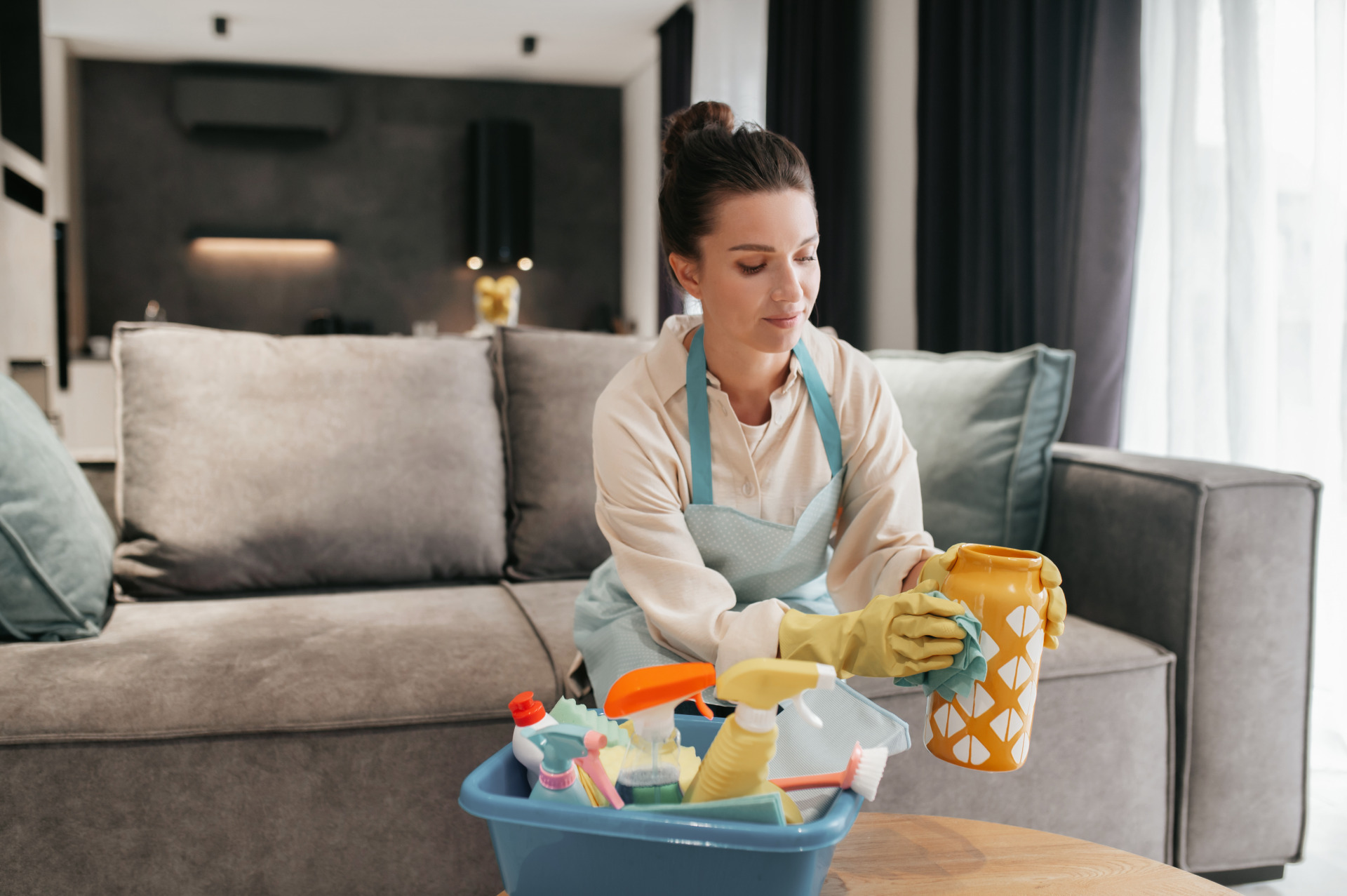Concrete floors have surged in popularity over the past decade, transforming from industrial spaces into stylish design elements for homes, offices, and commercial spaces. Whether you have polished concrete in your modern living room, stained concrete in your basement, or sealed concrete in your garage, proper cleaning and maintenance will keep these durable floors looking beautiful for decades.
This comprehensive guide covers everything you need to know about cleaning concrete floors—from daily maintenance to deep cleaning, stain removal, and long-term protection strategies.
Why Concrete Floors Need Special Care
While concrete is incredibly durable, it’s also porous and can be surprisingly delicate when it comes to cleaning products and techniques. Understanding concrete’s unique properties helps you clean it effectively without causing damage.
The Nature of Concrete
Porous Structure:
- Unsealed concrete absorbs liquids, oils, and stains quickly
- Dirt and grime can penetrate deep into the surface
- Moisture can cause efflorescence (white powdery deposits)
- Bacteria and mold can develop in damp concrete
Alkaline Composition:
- High pH level (typically 12-13 when fresh, settling to 9-10)
- Reacts with acidic cleaners if not properly sealed
- Can be damaged by incompatible cleaning products
- Requires pH-neutral or alkaline-safe cleaners
Surface Treatments Matter:
- Sealed concrete is more stain-resistant and easier to clean
- Polished concrete requires different care than raw concrete
- Stained or painted concrete needs gentle cleaning to preserve finish
- Waxed concrete demands specific maintenance routines
Types of Concrete Floors and Their Cleaning Needs
Different concrete finishes require tailored cleaning approaches:
Sealed Concrete Floors
Characteristics: Protected by topical sealer or coating Cleaning Approach: Gentle, avoiding harsh chemicals that strip sealer Frequency: Regular sweeping/mopping as needed Special Care: Resealing every 2-3 years
Polished Concrete Floors
Characteristics: Ground and polished to a high shine Cleaning Approach: Dust mopping and pH-neutral cleaners Frequency: Daily dust removal, weekly damp mopping Special Care: Periodic professional polishing to maintain shine
Stained Concrete Floors
Characteristics: Acid or water-based stains create color Cleaning Approach: Very gentle cleaning to preserve stain Frequency: Regular sweeping, occasional damp mopping Special Care: Avoid acidic cleaners and abrasive scrubbing
Raw/Unsealed Concrete
Characteristics: No protective coating, highly porous Cleaning Approach: More intensive cleaning, immediate spill cleanup Frequency: Regular sweeping, periodic deep cleaning Special Care: Consider sealing to reduce maintenance
Painted Concrete
Characteristics: Paint coating covers concrete Cleaning Approach: Gentle cleaning to avoid paint damage Frequency: Regular sweeping and damp mopping Special Care: Touch up paint as needed
Essential Supplies for Concrete Floor Cleaning
Having the right tools makes concrete cleaning easier and more effective:
Basic Cleaning Tools
For Daily Maintenance:
- Soft-bristle broom or dust mop
- Microfiber mop and pads
- Vacuum with hard floor attachment
- Soft cloths or towels
For Deep Cleaning:
- Stiff-bristle brush (for unsealed concrete)
- Soft-bristle scrub brush (for sealed concrete)
- Bucket for cleaning solutions
- Wet/dry vacuum for larger spaces
- Squeegee for water removal
For Stain Removal:
- Absorbent materials (cat litter, baking soda, sawdust)
- Soft scrubbing pads (non-abrasive)
- Old towels for blotting
- Plastic scraper for sticky residue
Recommended Cleaning Products
Safe for Concrete:
- pH-neutral floor cleaners
- Dish soap (mild, unscented)
- White vinegar (diluted, for sealed concrete only)
- Baking soda (gentle abrasive)
- Hydrogen peroxide (for stain removal)
- TSP (trisodium phosphate) for heavy-duty cleaning
Avoid These Products:
- Ammonia-based cleaners (react with concrete’s alkalinity)
- Acidic cleaners on unsealed concrete (muriatic acid only for specific purposes)
- Bleach on colored or stained concrete (causes discoloration)
- Oil-based soaps (leave residue and attract dirt)
- Harsh abrasive cleaners (scratch sealed surfaces)
Daily and Routine Concrete Floor Maintenance
Consistent maintenance prevents dirt buildup and extends your floor’s life:
Daily Quick Clean (5-10 minutes)
Step 1: Remove Loose Debris
- Sweep with a soft-bristle broom or use a dust mop
- Focus on high-traffic areas and entryways
- Pay attention to corners and edges where dirt accumulates
- Alternatively, vacuum with a hard floor attachment
Step 2: Spot Clean Spills
- Address spills immediately to prevent staining
- Blot liquids with absorbent cloth or paper towels
- For sticky spills, use slightly damp cloth with mild soap
- Dry area thoroughly after cleaning
Weekly Deep Clean (30-45 minutes)
Step 1: Thorough Sweeping or Vacuuming
- Remove all loose dirt, dust, and debris
- Use vacuum crevice tool for corners and edges
- Ensure floor is completely dry before mopping
Step 2: Prepare Cleaning Solution
- For sealed concrete: Mix pH-neutral cleaner per instructions
- For unsealed concrete: Use mild dish soap solution (1 tablespoon per gallon of water)
- Warm water enhances cleaning effectiveness
Step 3: Damp Mop the Floor
- Wring mop thoroughly—concrete needs damp, not wet mopping
- Work in sections, starting from furthest corner
- Change water when it becomes dirty
- Overlap strokes to ensure complete coverage
Step 4: Rinse if Necessary
- Some cleaners require rinsing with clean water
- Use clean mop and fresh water
- Remove all soap residue to prevent buildup
Step 5: Air Dry or Dry Manually
- Allow floor to air dry completely
- Use fans to speed drying in humid conditions
- Ensure good ventilation
- Avoid walking on wet concrete
Deep Cleaning Methods for Concrete Floors
For heavily soiled concrete or periodic intensive cleaning:
Method 1: pH-Neutral Cleaner Deep Clean
Best For: Sealed and polished concrete floors
Instructions:
- Sweep or vacuum floor thoroughly
- Mix pH-neutral concrete floor cleaner according to package directions
- Apply solution to floor using mop or soft-bristle brush
- Let solution sit for 5-10 minutes (don’t let it dry)
- Scrub gently with soft-bristle brush if needed
- Mop up dirty solution
- Rinse with clean water
- Dry floor completely with towels or air dry
Method 2: Vinegar Solution Clean
Best For: Sealed concrete with light buildup (NOT for unsealed concrete)
Instructions:
- Sweep or vacuum floor completely
- Mix solution: 1 cup white vinegar per gallon of warm water
- Apply with mop, keeping it damp not soaking
- Work in small sections
- No scrubbing needed for regular cleaning
- Rinse with plain water
- Dry thoroughly
Warning: Never use vinegar on unsealed, stained, or acid-sensitive concrete as it can cause etching and damage.
Method 3: Baking Soda Scrub
Best For: Stubborn stains on sealed concrete
Instructions:
- Sprinkle baking soda directly on stained area
- Add small amount of water to form paste
- Let sit for 15-30 minutes
- Scrub gently with soft-bristle brush
- Wipe away residue with damp cloth
- Rinse area with clean water
- Dry completely
Method 4: TSP Heavy-Duty Clean
Best For: Unsealed concrete with heavy grease or grime buildup
Instructions:
- Wear gloves and eye protection (TSP is caustic)
- Mix TSP according to package directions (typically 1/2 cup per gallon of water)
- Apply with mop or brush
- Scrub heavily soiled areas with stiff-bristle brush
- Let solution work for 10-15 minutes
- Rinse thoroughly with clean water multiple times
- Ensure all TSP residue is removed
- Allow to dry completely
Safety Note: TSP is a strong cleaner. Use in well-ventilated areas and follow all safety precautions.
Removing Specific Stains from Concrete
Different stains require targeted treatment approaches:
Oil and Grease Stains
Fresh Stains:
- Immediately cover with absorbent material (cat litter, sawdust, baking soda)
- Let absorb for several hours or overnight
- Sweep up absorbent material
- Apply dish soap directly to stain
- Scrub with stiff brush and hot water
- Rinse thoroughly
Set-in Oil Stains:
- Make paste with baking soda and water
- Apply thickly to stain
- Cover with plastic wrap and let sit 24 hours
- Remove paste and scrub with TSP solution
- For stubborn stains, use commercial degreaser
- Rinse multiple times
Rust Stains
Treatment:
- Create paste with lemon juice and baking soda
- Apply to rust stain
- Let sit for several hours
- Scrub with nylon brush
- Rinse thoroughly
- Repeat if necessary
- For severe rust, consider commercial rust remover safe for concrete
Paint Stains
Latex Paint:
- Scrape off dried paint with plastic scraper
- Apply warm soapy water to remaining residue
- Scrub with stiff brush
- Rinse clean
Oil-Based Paint:
- Use paint thinner or mineral spirits (in well-ventilated area)
- Apply to cloth and blot paint
- Scrub gently
- Rinse thoroughly with soap and water
- Rinse again with clean water
Organic Stains (Food, Wine, Coffee)
Treatment:
- Blot up excess liquid immediately
- Apply hydrogen peroxide directly to stain
- Let sit for 10-15 minutes
- Scrub with soft brush
- Rinse with water
- Repeat if necessary
Efflorescence (White Powder Deposits)
Treatment:
- Brush away loose deposits with dry brush
- Mix solution of 1 part white vinegar to 3 parts water
- Apply to affected area
- Scrub gently
- Rinse thoroughly
- Dry completely
- Address moisture source to prevent recurrence
Protecting and Sealing Concrete Floors
Sealing concrete significantly reduces maintenance and protects against stains:
Why Seal Concrete?
Benefits of Sealing:
- Creates barrier against stains and moisture
- Makes cleaning easier and more effective
- Enhances appearance and color
- Reduces dusting (especially in basements and garages)
- Extends floor lifespan
- Provides slip resistance options
When to Seal or Reseal
New Concrete:
- Wait at least 28 days for concrete to cure fully
- Ensure moisture content is below 4%
- Clean thoroughly before sealing
Existing Concrete:
- Reseal every 2-3 years for interior floors
- Reseal annually for high-traffic commercial spaces
- Reseal when water no longer beads on surface
- After deep cleaning or stain removal
Sealing Process Overview
Step 1: Prepare the Surface
- Clean floor thoroughly and remove all stains
- Repair any cracks or damage
- Allow floor to dry completely (48-72 hours)
- Remove any existing failing sealer if necessary
Step 2: Choose Appropriate Sealer
- Penetrating sealers: Soak into concrete for protection
- Topical sealers: Form protective layer on surface
- Consider finish: matte, satin, or glossy
- Select based on use: residential, commercial, garage
Step 3: Apply Sealer
- Follow manufacturer’s instructions precisely
- Apply in thin, even coats with roller or sprayer
- Work in manageable sections
- Allow proper drying time between coats
- Apply 2-3 coats for best protection
Step 4: Cure and Maintain
- Allow full cure time (typically 24-72 hours)
- Avoid heavy traffic during curing
- Wait recommended time before cleaning (often 7 days)
- Use only recommended cleaners to preserve sealer
Common Concrete Cleaning Mistakes to Avoid
Prevent damage by avoiding these common errors:
❌ Using Harsh Acidic Cleaners
Why It’s Bad: Acids etch unsealed concrete and damage sealers Instead: Use pH-neutral cleaners or properly diluted vinegar on sealed concrete only
❌ Over-Wetting the Floor
Why It’s Bad: Excess water seeps into concrete causing staining, efflorescence, and mold Instead: Use damp mop wrung out thoroughly; never flood concrete floors
❌ Using Ammonia-Based Products
Why It’s Bad: Reacts with concrete’s alkalinity, potentially causing damage and discoloration Instead: Choose ammonia-free, pH-neutral cleaners formulated for concrete
❌ Neglecting Regular Maintenance
Why It’s Bad: Dirt becomes embedded, stains set in, and damage accumulates Instead: Sweep daily, mop weekly, and address spills immediately
❌ Scrubbing with Steel Wool or Metal Brushes
Why It’s Bad: Scratches sealed surfaces and can leave metal particles that rust Instead: Use nylon brushes, soft-bristle brushes, or non-abrasive pads
❌ Ignoring Spills
Why It’s Bad: Concrete is porous; spills penetrate quickly causing permanent stains Instead: Clean spills immediately, especially oils, acids, and dark liquids
❌ Using the Wrong Sealer
Why It’s Bad: Incompatible sealers fail, yellow, or cause adhesion problems Instead: Research and choose appropriate sealer for your specific concrete type and use
Concrete Floor Cleaning by Location
Different areas have unique cleaning requirements:
Garage Concrete Floors
Challenges: Heavy oil, grease, tire marks, salt damage Cleaning Frequency: Weekly sweeping, monthly deep cleaning Special Considerations: Use degreaser regularly; seal to prevent oil penetration Best Practices: Clean up automotive fluids immediately; use floor mats
Basement Concrete Floors
Challenges: Moisture, efflorescence, musty odors, potential mold Cleaning Frequency: Bi-weekly sweeping, monthly cleaning Special Considerations: Address moisture sources; ensure proper ventilation Best Practices: Use dehumidifier; seal to prevent dusting and moisture issues
Kitchen and Bathroom Concrete
Challenges: Water exposure, spills, soap scum, high traffic Cleaning Frequency: Daily sweeping, twice-weekly mopping Special Considerations: Seal thoroughly; address water immediately Best Practices: Use mats in wet areas; immediate spill cleanup
Commercial and Retail Concrete
Challenges: Extremely high traffic, varied soil types, appearance standards Cleaning Frequency: Daily maintenance, weekly deep cleaning Special Considerations: Use commercial-grade sealers; schedule off-hours cleaning Best Practices: Implement entrance matting system; professional maintenance program
When to Call Professional Concrete Cleaning Services
Some situations benefit from professional expertise:
Large Commercial Spaces:
- Square footage too large for effective DIY cleaning
- Need for industrial cleaning equipment
- Time constraints requiring efficient professional service
- Maintenance contracts for consistent results
Severe Staining or Damage:
- Deep oil stains requiring commercial degreasers
- Extensive rust or paint stains
- Structural damage needing repair before cleaning
- Failing sealer requiring professional removal
Specialized Finishes:
- Polished concrete needing professional burnishing
- Decorative concrete requiring expert care
- High-value floors where mistakes are costly
- Complex staining or sealing projects
Move-In/Move-Out Situations:
- Ensuring pristine condition for new occupants
- Meeting landlord or sale requirements
- Time pressure for quick turnaround
- Guaranteed professional results
Recurring Maintenance Programs:
- Consistent professional care for high-traffic areas
- Scheduled deep cleaning and resealing
- Preventive maintenance to extend floor life
- Documentation for property management
Professional Concrete Floor Cleaning in Boston
At BraBos Cleaning Services, we understand that concrete floors are a significant investment deserving expert care. Our professional team has the knowledge, equipment, and experience to clean and maintain all types of concrete flooring throughout Boston.
Our Concrete Floor Cleaning Services
Comprehensive Cleaning:
- Assessment of concrete type and condition
- Appropriate product selection for your specific floors
- Professional-grade equipment for superior results
- Stain identification and targeted treatment
- Thorough cleaning without damage to finish or sealer
Specialized Care:
- Polished concrete maintenance
- Sealed concrete cleaning and care
- Stained concrete gentle cleaning
- Unsealed concrete deep cleaning
- Post-construction concrete cleanup
Complete Home and Commercial Cleaning
Beyond concrete floors, BraBos offers comprehensive cleaning solutions:
- Deep Cleaning Services – Intensive cleaning including all floor types
- House Cleaning – Complete home cleaning with floor care
- Apartment Cleaning – Perfect for modern apartments with concrete floors
- Commercial Cleaning – Professional cleaning for businesses with concrete flooring
- Recurring Cleaning Services – Regular maintenance to keep floors pristine
- Move-In/Move-Out Cleaning – Spotless floors for transitions
- One-Time Cleaning – Special floor cleaning projects
- Maid Services – Ongoing housekeeping including floor maintenance
Serving Concrete Floor Owners Throughout Boston
Whether you have polished concrete in your Seaport loft, stained floors in your South End townhouse, or sealed concrete in your Cambridge industrial space, BraBos serves all of Greater Boston:
Boston Neighborhoods: South End, Back Bay, South Boston, Allston, Bay Village, Beacon Hill, Brighton, Charlestown, Chinatown, Dorchester, Downtown, East Boston, Fenway-Kenmore, Hyde Park, Jamaica Plain, Mattapan, Mission Hill, North End, Roslindale, Roxbury, Seaport, West End, West Roxbury
Surrounding Communities: Brookline, Cambridge, Newton, Lexington, Belmont, Arlington, Wellesley, Natick, Needham, Winchester, Milton, Watertown, Somerville, Wakefield, Reading, Melrose, Burlington, Waltham, Medford, Norwood, Braintree, Framingham, Quincy, Dedham, Woburn, Malden, Stoneham, Wilmington, Winthrop, Methuen, Saugus, Revere, Peabody, Everett, Lynn, Canton
Get Professional Concrete Floor Cleaning Today
Don’t risk damaging your beautiful concrete floors with improper cleaning methods or products. Trust the professionals at BraBos Cleaning Services to keep your floors looking their best.
Ready for expertly cleaned concrete floors?
✓ Book online for convenient scheduling ✓ Get a free quote tailored to your needs
With over 7 years of experience, fully trained and insured professionals, and our 100% Satisfaction Guarantee, you can trust BraBos to care for your concrete floors with the expertise they deserve.







